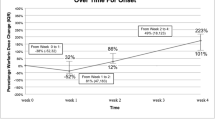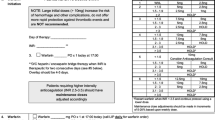Abstract
To evaluate the utility of a preemptive warfarin dose reduction at the time of initiation of either sulfamethoxazole-trimethoprim or metronidazole, a retrospective chart review of patients who received an outpatient prescription for warfarin and either sulfamethoxazole-trimethoprim and/or metronidazole from July 1, 2011 to July 1, 2015 was conducted. Clinical outcomes compared Veterans who had a warfarin dose reduction and those who did not within 120 h (5 days) of antibiotic initiation. The primary outcome compared the pre-and post-antibiotic International Normalized Ratio (INR) of patients in the intervention group (warfarin dose reduction) with those in the control group (no intervention). Secondary outcomes assessed incidence of thromboembolic and major bleeding events within 30 days of antibiotic completion. Fifty patients were assessed. Forty-nine patients had at least one follow-up appointment; 126 follow-up visits were evaluated. There was a statistically significant difference for the change in therapeutic INR at the first follow-up appointment (p = 0.029) for those patients in the control group. On average, the patients in the intervention group required fewer follow-up visits (p = 0.019). There were no statistically significant differences for the overall rate of therapeutic INR values between groups, as well as no instances of a thromboembolic or major bleeding events during the follow-up period. Clinically significant differences were observed for patients who received a preemptive warfarin dose reduction upon initiation of sulfamethoxazole-trimethoprim or metronidazole. Patients in the intervention group required fewer follow-up appointments and were more likely maintain a therapeutic INR within the 30 days following the antibiotic course. Results of this study will be presented the at Pharmacy and Therapeutics committee in an effort to seek approval for policy development to initiate a local preemptive warfarin dose adjustment as a standard of practice.
Similar content being viewed by others
References
Ageno W, Gallus AS, Wittkowsky A et al (2012) American college of chest physicians evidence-based practice guidelines. Oral anticoagulant therapy. Chest 141:e44S–e88S. doi:10.1378/chest.11-2292
Nelson WW, Wang L, Baser O, Damaraju CV, Schein JR (2015) Out-of-range international normalized ratio values and healthcare cost among new warfarin patients with non-valvular atrial fibrillation. J Med Econ 18:333–340. doi:10.3111/13696998.2014.1001851
Ahmed A, Stephens JC, Kaus CA, Fay WP (2008) Impact of preemptive warfarin dose reduction on anticoagulation after initiation of trimethoprim-sulfamethoxazole or levofloxacin. J Thromb Thromb 26:44–48. doi:10.1007/s11239-007-0164-z
Baillargeon J, Holmes HM, Lin Y, Raji MA, Sharma G, Kuo YF (2012) Concurrent use of warfarin and antibiotics and the risk of bleeding in older adults. Am J Med 125(2):183–189. doi:10.1016/j.amjmed.2011.08.014
Nutescu EA, Wittkowsky AK, Burnett A et al (2013) Delivery of optimized inpatient anticoagulation therapy: consensus statement from the anticoagulation forum. Ann Pharmacother 47(5):714–724. doi:10.1345/aph.1R634
Chesebro JH et al (1987) Thrombolysis in myocardial infarction (TIMI) trial phase I a comparison between intravenous tissue plasminogen activator and intravenous streptokina. Circulation 76(1):142–154
Lane DA, Lip GY (2012) Use of the CHA(2)DS(2)-VASc and HAS-BLED scores to aid decision making for thromboprophylaxis in nonvalvular a trial fibrillation. Circulation 126(7):860–865
Santos-Gallego CG, Bayón J, Badimón JJ (2010) Thrombi of different pathologies: implications for diagnosis and treatment. Curr Treat Options Cardiovasc Med 12(3):274–291
Budnitz D (2007) Medication use leading to emergency department visits for adverse drug events in older adults. Ann Intern Med 147(11):755–765
Anticoagulation U.S. Department of Health and Human Services, Office of Disease Prevention and Health Promotion (2014) National action plan for adverse drug event prevention. Washington, DC
Rose AJ, Hylek E, Ozonoff A, Ash AS, Reisman JI, Berlowitz DR (2010) Patient characteristics associated with oral anticoagulation control: results of the veterans affairs study to improve anticoagulation (VARIA). J Thromb Haemost 8:2182–2191. doi:10.1111/j.1538-7836.2010.03996.x
Pokorney SD, Simon DN, Thomas L et al (2015) Patients’ time in therapeutic range on warfarin among US patients with atrial fibrillation: results from ORBIT-AF registry. Am Heart J 170(1):141–148. doi:10.1016/j.ahj.2015.03.017
Hersh EV, Pinto A, Moore PA (2007) Adverse drug interactions involving common prescription and over-the-counter analgesic agents. Clin Ther 29:2477–2497. doi:10.1016/j.clinthera.2007.12.003
Lane MA, Zeringue A, Mcdonald JR (2014) Serious bleeding events due to warfarin and antibiotic co-prescription in a cohort of veterans. Am J Med 127(7):657–663. doi:10.1016/j.amjmed.2014.01.044
Acknowledgements
A special thanks to Dr. Aleda Chen and Cedarville University for performing statistical analyses for this manuscript. The views and opinions expressed in this article are those of the authors and do not reflect official policy or the position of the Department of Veterans Affairs or the United States Government.
Author information
Authors and Affiliations
Corresponding author
Ethics declarations
Ethical approval
This article does not contain any studies with human participants or animals performed by any of the authors.
Rights and permissions
About this article
Cite this article
Powers, A., Loesch, E.B., Weiland, A. et al. Preemptive warfarin dose reduction after initiation of sulfamethoxazole-trimethoprim or metronidazole. J Thromb Thrombolysis 44, 88–93 (2017). https://doi.org/10.1007/s11239-017-1497-x
Published:
Issue Date:
DOI: https://doi.org/10.1007/s11239-017-1497-x




